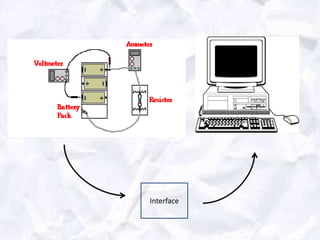Data Logging
- 1. SSI 3013: Information and Communication Technology in Science Group members: Nor Fadilah Bt Zakaria D20101037413 Nur Faralina Bt Asrab Ali D20101037415 Syazana Bt Ismail D20101037417 Title : Data Logging (Ohmâs Law)
- 2. ENGAGE 1) How energy is supply to a circuit ? 2) What are the differences in current flow between series and parallel circuit? 3) What will happen to resistance if the circuit is wire in series and parallel ? 4) In what way does the series circuit reduce the resistance? 5) How to build wire in parallel and series circuit?
- 3. Empower Objectives To experimentally verify Ohmâs Law through measurement and to confirm findings by comparing measured values with prediction. Measuring Instrument Voltage/Current Sensor PASPORT Interface Crocodile clips 11.2 ohm Resistor Batteries (D Cells)
- 4. Procedure: 1. Connect the PASPORT Interface to the USB port of the computer and plug the Voltage/Current Sensor into the PASPORT Interface. 2. Construct a simple series circuit with the empty battery holder, long bulb in socket, and voltage/current sensor . 3. You are now ready to begin collecting data. Data Collection Procedure: 1. Make sure you have good connections at each junction in the circuit. 2. Place one D cell in the battery holder; the bulb should light. If not, troubleshoot your circuit for a complete conducting path. 3. Click Start and note the readings on the voltage and current digits displays. 4. Record the voltage and current in the data table.
- 5. Result Part 1 Resistance = 11.2 Âą 0.1 ÎĐ DataStudio Slope: 10.8 Âą 0.59 ÎĐ Measured Values Voltage (Volts) Current (Amps) 0.352 0.031 0.364 0.032 0.374 0.034 0.394 0.034 0.403 0.038 0.439 0.04 0.451 0.041 0.475 0.042 0.509 0.046 0.548 0.049
- 6. Interface
- 8. ENHANCE Principles Ohmâs Law can be written algebraically as V = IR , where V represents the potential drop across the conductor (measured in volts), I the current in the conductor (measured in amperes), and R the resistance of the conductor measured in units called âohmsâ (symbolized by âĶ, upper- case Greek omega)
- 9. How voltage, current, and resistance relate The current flowing through a resistor at a constant temperature is directly proportional to the voltage across the resistor. So, if you double the voltage, the current also doubles. This is called Ohm's Law. The graph shows what happens to the current and voltage when a resistor follows Ohm's Law. Relationship between current and voltage when a resistor follows Ohm's Law
- 10. âĒ Use in all electrical devices that need a continuous flow of electric current to function. âĒ Batteries and generators provide the electricity and electrical circuits provide the paths along which the current flow.
- 11. âĒ Flash light âĒ Christmas tree light bulb âĒ Train lighting âĒ Voltage divider âĒ Or any of electrical appliancesâĶ.
- 12. âĒ Kitchen appliances such as electric mixer and light dimmer switches operate by altering the current at the load by increasing or decreasing the resistance of the circuit. âĒ The effect of the resistance in the circuit that affect the current.
- 13. MORAL VALUES FROM OHMâS LAW 1. We known how to use electricity properly 2. Become more creative and innovative person 3. More appreciate the Ohmâs Law 4. Ohms Law is the a foundation stone of electronics and electricity. Without the Ohmâs law, there will be no electricity at all. 5. Allows us to enjoy the uses of our appliances now such as TV, refrigerator, Players, etc.
- 14. Advantages of Data Logging 1. Better learning outcomes 2. Presentation of data 3. Appreciation of modern technology 4. Increased level of interest among students. 5. Data from the computer more accurate and precise.













